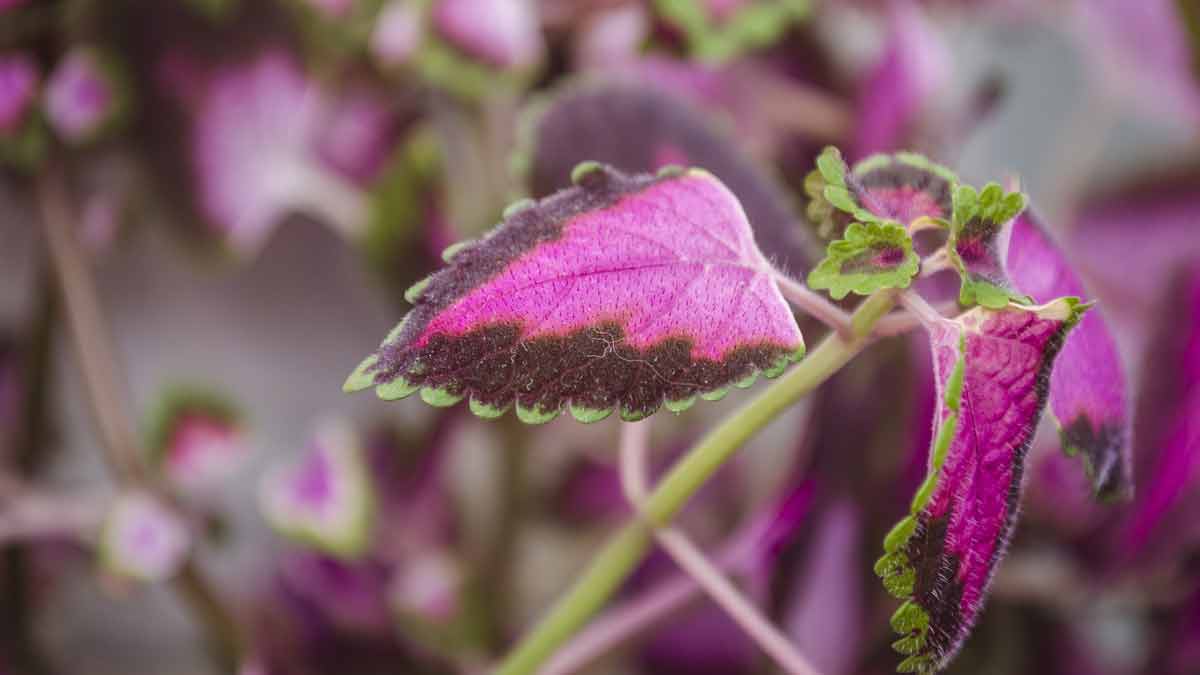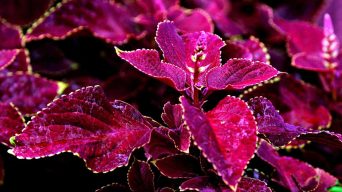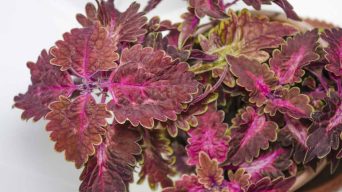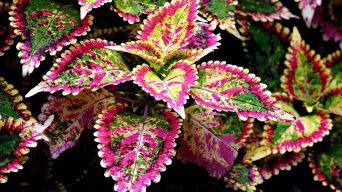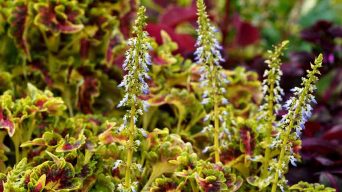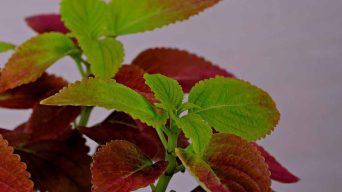Coleus plants are beautiful, easy-to-grow additions to any garden or home. They come in a wide variety of colors and patterns and are relatively low-maintenance.
However, like all plants, they can sometimes experience problems.
One common issue is drooping leaves.
But what do you do when you see your Coleus leaves drooping?
There are a few possible reasons for this problem, but fortunately, several solutions exist.
Keep reading to learn more about why your Coleus leaves might be drooping and what you can do about it.
Why Are My Coleus Leaves Drooping and What Can I Do About It?
There are a few possible reasons why your Coleus leaves might be drooping.
The most common include:
1. Underwatering
One of the most common reasons for Coleus leaves to droop is underwatering.
Coleus plants need to be kept moist but not soggy.
If the soil is too dry, the leaves will start to droop to conserve water.
Underwatering can happen for several reasons. You might be forgetful or have placed your Coleus in an area that gets a lot of sun and dries out quickly.
How To Tell If You’re Underwatering Your Coleus
A few signs can help you tell if you’re underwatering your Coleus.
In addition to drooping leaves, you might also see:
- Brown or yellow leaves
- Dry, brittle leaves
- Soil that is dry and crumbly
- Slow growth
How To Treat Underwatering
If you think you might be underwatering your Coleus, water it thoroughly and recheck the soil after a few hours.
If the soil is still dry, water it again.
You should also ensure you’re watering your Coleus regularly in the future to prevent the problem from happening again.
Coleus plants need about 1-2 inches of water per week, so water them deeply about once or twice a week.
2. Overwatering
While underwatering is a common problem, overwatering can also be an issue.
Coleus plants need to be kept moist, but too much water can cause the roots to rot and the leaves to droop.
Overwatering can happen for several reasons. You might be watering too often or have placed your Coleus in an area with poor drainage.
How To Tell If You’re Overwatering Your Coleus
A few signs can help you tell if you’re overwatering your Coleus.
In addition to drooping leaves, you might also see:
- Yellow or brown leaves
- Leaves that are wilting, not just drooping
- Soil that is soggy or waterlogged
- Mold or mildew on the leaves or stems
- Slow growth
- Root rot
How To Treat Overwatering
If you think you might be overwatering your Coleus, stop watering it for a few days and check the soil.
If the potting soil is still wet, don’t water it again until it has had a chance to dry out.
You should also ensure that you’re watering your Coleus less often in the future to prevent the problem from happening again.
You also need to make sure that your Coleus has good drainage. Water should be able to drain quickly from the pot or bed where it’s growing.
3. Low Humidity
Coleus plants need high humidity to thrive.
If the air is too dry, the leaves will start to droop to conserve moisture.
Low humidity is often a problem in homes, especially in winter when heating systems make the air drier.
How To Tell If The Air Is Too Dry
A few signs can help you tell if the air is too dry.
In addition to drooping leaves, you might also see:
- Brown leaves
- Leaves that are wilting, not just drooping
- Dry, brittle leaves
- Slow growth
How To Increase Humidity
If you think the air might be too dry, you can do a few things to increase humidity.
You can place your Coleus plant on a tray of pebbles and water. This will create a humid microclimate around the plant.
If you have a humidifier, you can use it to increase the humidity in the room where your Coleus is growing.
You can also group your Coleus plants together. This will create a mini greenhouse effect and increase the humidity around the plants.
4. Not Enough Sunlight
Coleus plants need bright, indirect light to thrive.
If they don’t get enough light, the leaves will start to droop to conserve energy.
Light provides the energy that Coleus plants need to produce food through photosynthesis.
Without enough light, the plants will start to starve, and the leaves will droop because there isn’t enough energy to support them.
How To Tell If Your Coleus Isn’t Getting Enough Light
A few signs can help you tell if your Coleus isn’t getting enough light.
In addition to drooping leaves, you might also see:
- Yellow or pale leaves
- Leaves that are wilting, not just drooping
- Slow growth
- Spindly, leggy growth
- The plant leans towards the light
How To Increase Light
If you think your Coleus isn’t getting enough light, move it to a brighter spot.
Coleus plants need bright indirect light, so a spot near an east- or west-facing window is ideal.
Be careful not to place it in direct sunlight, as this can scorch the leaves.
Coleus needs at least four hours of light daily, but they will do best with six to eight hours.
If you can’t provide enough natural light, you can supplement it with artificial lighting.
Fluorescent lights are a good option for Coleus plants.
5. Heat Stress
Coleus plants are native to tropical regions, and they prefer warm temperatures.
However, they can’t tolerate the heat for too long. If the temperatures get too high, the leaves will start to droop to conserve moisture.
How To Tell If The Heat stresses your Coleus
A few signs can help you tell if the heat stresses your Coleus.
In addition to drooping leaves, you might also see:
- Yellow or brown leaves
- Leaves that are wilting, not just drooping
- Curling leaves
- Soil that is dry and dusty
- Slow growth
- The plant stops blooming
How To Reduce Heat Stress
If you think the heat stresses your Coleus, you can do a few things to help it.
First, move the plant to a cooler spot. If possible, find a place that gets morning sun and afternoon shade.
You can also increase the humidity around the plant by misting it with water or placing it on a tray of pebbles and water.
If you live in a particularly hot climate, you might need to take your Coleus plants indoors during summer.
You also need to be aware of sudden temperature changes. Sudden changes, especially from hot to cold, can shock the plants and cause the leaves to droop.
6. Transplant Shock
Transplant shock is a common problem with Coleus plants. It happens when the roots are disturbed during transplanting and have difficulty adjusting to their new environment.
The leaves will start to droop as the plant tries to conserve energy while it recovers from the transplant.
Transplant shock can also happen if you move your Coleus plant to a new pot that is too big. The roots will be disturbed as they try to fill the new pot, and the leaves will droop.
How To Tell If Your Coleus Is Suffering From Transplant Shock
A few signs can help you tell if your Coleus is suffering from transplant shock.
In addition to drooping leaves, you might also see:
- Leaves that are wilted or yellowing
- Damaged roots
- Stunted growth
- Slow growth
How To Treat Transplant Shock In Coleus Plants
If you think your Coleus plant is suffering from transplant shock, the best thing you can do is to give it some time.
The plant will need to adjust to its new environment, and the roots will need to recover.
You can help the plant by ensuring it has plenty of water and keeping it in a warm, sunny spot.
Do not fertilize the plant until it has recovered from the transplant shock.
You can try transplanting it to a new pot if it does not recover within a few weeks. This time, ensure the pot is not too big, and the roots are not disturbed too much.
7. Pest Infestation
Pests can be a problem for Coleus plants. The most common pests are aphids, mealybugs, and whiteflies.
These pests suck the sap from the leaves and stems of the plant, causing the leaves to droop. They can also cause coleus leaves to turn yellow and wilt.
Aphids, mealybugs, and whiteflies can also spread diseases to Coleus plants.
How To Tell If Your Coleus Plant Is Infested With Pests
A few signs can help you tell if your Coleus plant is infested with pests.
In addition to drooping leaves, you might also see:
- Leaves that are yellowing or wilting
- Stunted growth
- Holes in the leaves
- Tiny bugs on the leaves or stems
- Eggs or larvae on the plant
How To Control Pests On Coleus Plants
If you think your Coleus plant is infested with pests, the best thing you can do is to isolate the plant from other plants.
This will prevent the pests from spreading.
You can then remove the pests by hand. Use a cotton swab dipped in rubbing alcohol to remove aphids and mealybugs. Use a stiff brush to remove whiteflies.
You can also use a natural insecticide, such as neem oil, to control pests on Coleus plants.
To use neem oil, mix it with water according to the instructions on the bottle. Then spray it on the plant, being sure to cover all of the leaves.
You will need to reapply the neem oil every few days until the pests are gone.
How To Prevent Coleus Leaves From Drooping
You can do a few things to help prevent your Coleus leaves from drooping.
Some of these include:
- Make sure your Coleus is getting enough light. Coleus plants need at least six hours of sunlight each day to stay healthy. If your Coleus is not getting enough light, its leaves will start to droop.
- Water your Coleus regularly. Coleus plants need to be kept moist but not too wet – water your Coleus when the top inch of soil is dry to the touch.
- Avoid overwatering your Coleus. Overwatering can cause the roots of your Coleus to rot, which will lead to the leaves drooping.
- Fertilize your Coleus regularly. Coleus plants need to be fertilized every two weeks during the growing season. Use a water-soluble fertilizer that is high in nitrogen.
- Prune your Coleus regularly. Pruning helps to promote new growth and keeps your Coleus plant healthy.
- Keep your Coleus plant free from pests and diseases. Pests and diseases can weaken your Coleus plant and cause the leaves to droop.
- Keep your Coleus plant in a humid environment. Coleus plants thrive in moist conditions. If the air is too dry, the leaves of your Coleus will start to droop.
Following these tips can help prevent your Coleus leaves from drooping.
Final Thoughts
If your Coleus leaves are drooping, there could be several reasons why.
Most often, it is due to too little water or not enough light. However, it could also indicate too much water or pest infestation.
Whatever the reason, it is essential to take action as soon as you notice the issue. This will help ensure that your Coleus plant stays healthy and vibrant.

